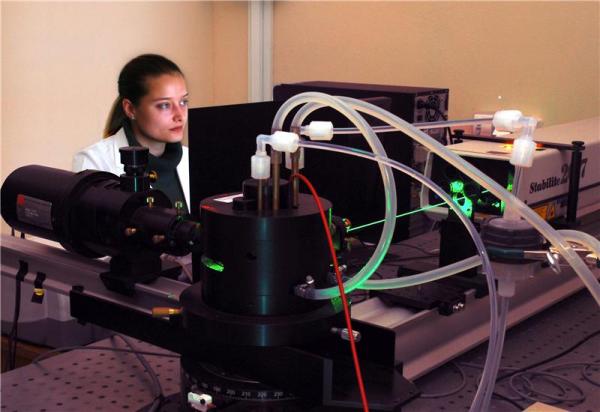Why do biological processes take place in the cell nucleus? The environment there is so dense with macromolecules, so viscous, that proteins move very slowly in it. Under these conditions, the rate at which proteins organize into complex structures and help join together DNA chains cannot be efficient

Lazily - this is the rate at which proteins move inside living cells where the viscosity of the environment is much higher than the viscosity of water millions of times. On the other hand, the movement of proteins is not slower than in water itself. While trying to find a solution to this mystery, scientists from the Institute of Physical Chemistry at the Polish Academy of Sciences discovered a new physical principle.
Why do biological processes take place in the cell nucleus? The environment there is so dense with macromolecules, so viscous, that proteins move very slowly in it. Under these conditions, the rate at which proteins organize into complex structures and help join DNA chains together cannot be efficient. "However, we know that proteins in living cells move hundreds of thousands of times faster than they are supposed to. We were able to understand why this happens," says Professor Robert Hołyst from the Institute of Physical Chemistry at the Polish Academy of Sciences.
Our human senses do not allow us to detect changes occurring in a viscous environment. The viscosity of an oil spill seems to us, relatively, similar to that of water, even though water has a viscosity 400 times smaller than oil. As a result, we often confuse viscosity with density. For example, shampoo contains 95% water and has a density similar to it, but due to its high viscosity it drips slowly near us. Honey is also viscous, not dense.
Viscosity, as a physical measure, first appeared in the Navier-Stokes equations developed at the beginning of the nineteenth century. The equations correctly described the river currents and the air currents around the wings of an airplane. According to this discovery, viscosity does not depend on the physical scale in which it operates and should lead to the same results in the case of a flying airplane and a protein particle moving inside the cell nucleus. However, the measurements prove otherwise. Starting from the fifties of the last century, experiments, conducted in extremely fast centrifuges in the field of deposition of tiny particles under conditions of high load, revealed a surprising fact. It turned out that objects that are billions of times smaller are able to "sense" a viscosity that is thousands or even hundreds of thousands times smaller than that of macroscopic objects. The reason for this significant difference in viscosity has not been clarified for a long time, about fifty years.
Although viscosity was already examined in the past by Newton, it remains an unknown property of nature to this day. We were able to understand its origin in the gaseous state: when two layers of gas move towards each other, a particle may jump from one layer to the other, collisions between the particles occur and the overall motion becomes slower. However, when the gas becomes denser to the point of liquefaction, there are further interactions between the particles and then it is more difficult to find the origin of the viscosity phenomenon. As a result, scientists still study viscosity in the simplest model of a mixture of argon gas atoms and atoms of another noble gas.
A group of researchers from the Institute of Physical Chemistry at the Polish Academy of Sciences recently demonstrated that in every hydrodynamic system there is a basic scale at which a transition from macroviscosity to nanoviscosity occurs. The size of this scale depends on the size of the objects present in the liquid: in the case of polymers it will be the size of a random coil and in a solution of viruses - the length of the virus. "If the size of the polymer is ten nanometers, then any component that is immersed in the polymer solution and is larger than the polymer chain will feel macro-viscosity, and any component smaller than the polymer - nano-viscosity," explains the researcher.
It is interesting to know that the changes in viscosity are exponential (exponential), meaning that near the basic scale the changes are very sharp. A reduction in the size of the objects in the solution may result in a viscosity change of up to five or six orders of magnitude. The findings of this research mean that the hydrodynamic equations that exist today, where the viscosity value is constant, will have to be updated in the future.
From a scientific point of view, research on nanoviscosity is extremely important since this type of viscosity affects the pulsation rate of particles and limits the speed of biochemical reactions within living cells. "It is no coincidence that proteins in cells, especially the smallest ones, organize together to form complex arrays only near the site where the biochemical reaction is supposed to take place. This mechanism is necessary because large systems will move a million times slower than each individual protein," explains the researcher. The researchers hope that their discovery will be useful in industry, where viscosity plays a key role in many biotechnological reactions. Manufacturers of shampoo and cosmetic products will certainly benefit from the new findings. The discovered physics principles will also be important in the design of nanodevices. "Science still has difficulty fully understanding the phenomena that occur on a tiny scale. If we are interested in making nanomachines, we will have to learn as much as possible about the typical phenomena of the environment in which they are supposed to operate," notes the lead researcher.

2 תגובות
to anonymous
sorry and sorry
This is, of course, Tsal: "Biochemistry within me".
In your heart?